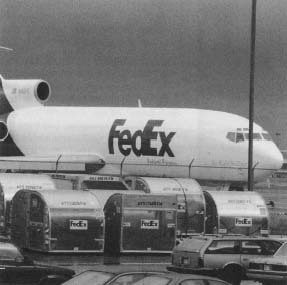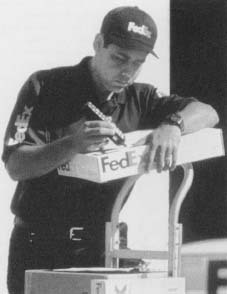FedEx Corporation
942 South Shady Grove Road
Memphis, TN 38120
(901) 369-3600
www.fedex.com
Since 1973 customers have turned to Federal Express when their important documents and small packages "absolutely, positively" must reach their destinations by the next morning. Over the years, founder Fred Smith transformed the company into the world's leading overnight shipper and a major force in ground shipping. Overnight delivery service increased the speed of business activity, first in the United States and then around the world. In 1994, Federal Express changed its name to FedEx since the shortened nickname had become so popular; most customers even used it as a verb. People didn't simply ship a package, they "Fedexed" it.
From College Term Paper to New Company
In 1965, while attending Yale University, Fred Smith wrote an economics paper exploring how goods were transported in the United States. At the time, shippers focused on transporting large packages across the United States by truck or inside passenger airplanes. Smith thought that a company carrying small, essential items by plane could be a more efficient transporter than existing companies. Smith wrote the paper at the last minute and did not go into details about how to actually run such a company. His professor gave him a "C" for the work. Smith, however, never stopped thinking about creating an express delivery system.
In 1971, after serving in the Vietnam War (1959-75), Smith finally had the chance to put his idea into action. He already owned two Dassault Falcons, small French-made airplanes. In June, he officially launched the Federal Express Corporation while still trying to land his first customer, the Federal Reserve System. The "Fed" serves as the U.S. government's central bank, with twelve district banks around the country. Smith told the Fed he could transport checks and other documents between the banks overnight, greatly reducing the existing delivery time. His idea was to fly the documents to a central airport—a hub—and then fly them out to their final destinations along air routes called "spokes." The Federal Reserve deal fell through, but the hub-and-spoke concept remained at the heart of the FedEx system.
During the next two years, Smith and his advisers studied how they could make an impact in air-cargo transport. Their focus was on high-priority items that weighed less than fifty pounds, such as computer parts or medical supplies. With those kinds of items, fast deliveries were crucial—and so was the company's ability to meet its tight schedules. As Smith said in a 2001 interview with Fast Company magazine, "When you have one of those parts, and a computer is down, or a hospital is in need of something, you really have to do what you say you're going to do."
FedEx at a Glance
- Employees: 215,000
- CEO: Fred Smith
- Subsidiaries: Caliber System, Inc.; Flying Tigers Ltd.; RPS, Inc.; Viking Freight, Inc.
- Major Competitors: United Parcel Service; Airborne Express; DHL Worldwide Express; U.S. Postal Service
- Notable Companies: FedEx Express; FedEx Ground; FedEx Freight; FedEx Home Delivery; FedEx Custom Critical; FedEx Trade Networks
As he planned his company, Smith searched for investors so he could buy more planes. By March 1973, FedEx had nine Falcons and was ready to start its service in the Midwest and South, with the hub located in Memphis, Tennessee. Leased trucks would carry packages to and from the airports. On March 12, FedEx employees gathered at the Memphis airport to watch the first night's load arrive. Only six packages arrived in Memphis, and one of them had been sent by Smith. The next month, FedEx tried again and this time 186 packages arrived, marking the company's official beginning.
Timeline
- 1971:
- Founder Fred Smith incorporates Federal Express.
- 1973:
- From its hub airport in Memphis, Tennessee, FedEx begins service to twenty-five U.S. cities.
- 1977:
- Deregulation of airlines lets FedEx carry more cargo on larger planes.
- 1981:
- FedEx introduces the overnight letter.
- 1984:
- International operations start after the purchase of Gelco Express International.
- 1986:
- FedEx introduces hand-held bar code scanners to track packages.
- 1989:
- The ZapMail fax service, introduced in 1984, is shut down; FedEx expands its overseas services with the purchase of Tiger International, parent company of Flying Tigers.
- 1990:
- FedEx wins the Malcolm Baldridge National Quality Award for its excellent customer service.
- 1994:
- The Federal Express Corporation officially changes its name to FedEx.
- 1998:
- The purchase of Caliber System, Inc. increases FedEx's truck fleet.
- 2001:
- Annual FedEx sales reach $20 billion, and the company carries packages to 210 countries.
Struggles and Successes
During the next several years, FedEx won some national attention, but not all of it was positive. The company lost millions of dollars its first year, and Smith drew more bad publicity in 1975 when he was accused of forging documents to obtain loans for FedEx. Cleared of the charge, Smith kept control of the company he founded. FedEx made its first profit in July 1975, though it still owed large sums of money.
FedEx's situation improved in 1977 when the U.S. government deregulated the air cargo industry. Old regulations had limited how much cargo a plane could carry. When Congress removed those limits, FedEx quickly expanded its business by flying larger planes. The Falcons were replaced with Boeing 727's and 737's and DC-10's built by McDonnell Douglas (see The Boeing Company entry).
As it introduced larger planes, FedEx perfected the hub-and-spoke system. It replaced leased trucks with its own fleet and ran a precise operation to guarantee delivery by noon the next day for its premium service. (This deadline was pushed up to 10:30 A.M. in 1982.) For example, FedEx drivers in Kansas City collected packages at offices and centrally located drop-off boxes, then brought them to a warehouse. From there, the packages went to the local airport and were flown to Memphis. At the hub, workers—mostly part-time college students—sorted the incoming packages and loaded them on planes. The aircraft that brought the Kansas City packages then returned to its home city, carrying items from around the country. In the morning, the packages were put on trucks to be delivered across Kansas City. This same kind of activity was repeated in hundreds of cities across America every working day.
By the early 1980s, FedEx was clearly a winner in the express-delivery industry—an industry it had invented. Competitors such as United Parcel Service (UPS) and Emery had to spend millions of dollars to buy their own planes and try to match FedEx's service. By then, however, FedEx had an advantage, since it had been the first company to tap the overnight-delivery market.
In a typical twenty-four-hour period, FedEx planes travel 500,000 miles, which is the equivalent of circling the globe twenty times.
More Growth—and Growing Pains
FedEx expanded its business line in 1981, adding the overnight delivery of letters and documents. The company also started operating around the world. In 1984, it bought Gelco Express International, an international package shipper based

In its quest to improve quality, the company introduced Service Quality Indicator (SQI) in 1988. Under this system, the company tracked such customer complaints as lost packages, missed pick-ups, and late deliveries. Each complaint was given a point value from 1 to 10. The company goal was to reduce its SQI score while shipping more packages. By then FedEx employees were using hand-held scanners to read the bar codes on invoices. The information on the bar code went into a computer to track the location of packages throughout their journey.
By 1989, sales reached more than $4 billion per year. Internationally, the company grew again when it bought Flying Tigers, another air-cargo delivery company specializing in the overseas market. The purchase, however, added to FedEx's debt, and foreign losses soon reached $200 million. In 1992, the company stopped shipping packages within Europe to focus on shipping goods to and from Europe. The next year, the

During the 1990s, FedEx also faced struggles with labor unions. Earlier, the International Brotherhood of Teamsters (who represent truck drivers and many airline workers) and the United Pilots Association had tried but failed to recruit FedEx employees into their unions. In 1992, FedEx pilots voted to join the Air Line Pilots Association. They became the company's only unionized workers, and in 1994 they asked for pay raises and improved benefits. For the next several years, FedEx and the pilots wrestled over these issues and sometimes clashed in court. A Teamsters spokesman told the National Journal in 2001, "FedEx has spent tens of millions of dollars fighting unions, rather than spending tens of millions of dollars to help their workers."
Smith always thought FedEx workers did not need unions, since the company tried hard to treat its employees well. For many years it had a policy of not laying off workers during bad times. It encouraged open communication with all employees and had its own satellite television network to send news to workers around the world. FedEx also stressed employee training and giving workers the freedom to take risks, if it meant serving the customer.
Responding to Change
Entering the twenty-first century, FedEx was the largest air-express shipper in the world, carrying more than three million packages every day on more than six hundred planes. It also played a larger role in ground shipping, after its 1998 purchase of Caliber System, a trucking company. In 2000, the company introduced FedEx Home Delivery, a new ground delivery service to bring packages from businesses to homes. The move was a reaction to the growing number of consumer purchases made on the Internet. The September 11, 2001, terrorist attacks on New York City and Washington, D.C., kept FedEx's planes on the ground for two days, so its growing fleet of trucks played a huge role in keeping packages moving.
Zap is a Zero
Along with FedEx's successes was one notable flop. In the early 1980s, FedEx feared losing business to the increasingly popular fax machine. The solution was for the company to fax documents from one of its offices to another, charging customers a fee to pick up the original documents and deliver the faxed pages. FedEx introduced its ZapMail service in 1984, but the business never caught on. As the price of fax machines fell, more companies could afford to buy them instead of paying FedEx to do the faxing for them. ZapMail shut down in 1989, after costing FedEx more than $300 million.
At the beginning of 2001, FedEx announced a deal with the United States Postal Service. FedEx began carrying packages for the Postal Service on certain flights and was allowed to place its drop-off boxes at thousands of post offices. The company continues to find new ways to meet the shipping needs of customers around the world.
Comment about this article, ask questions, or add new information about this topic: